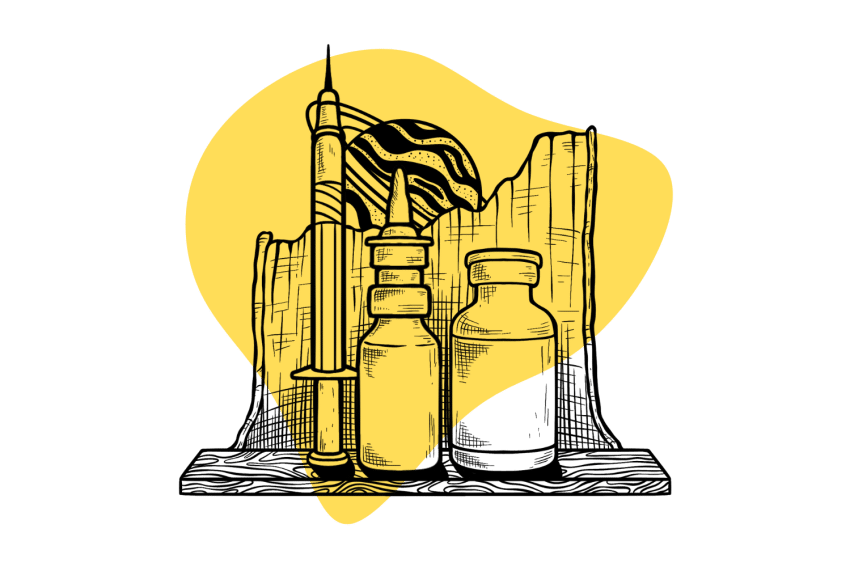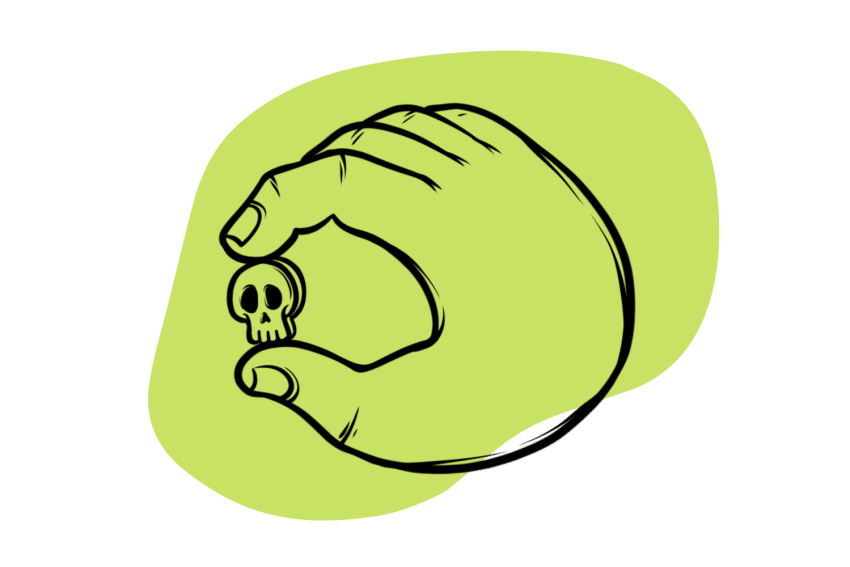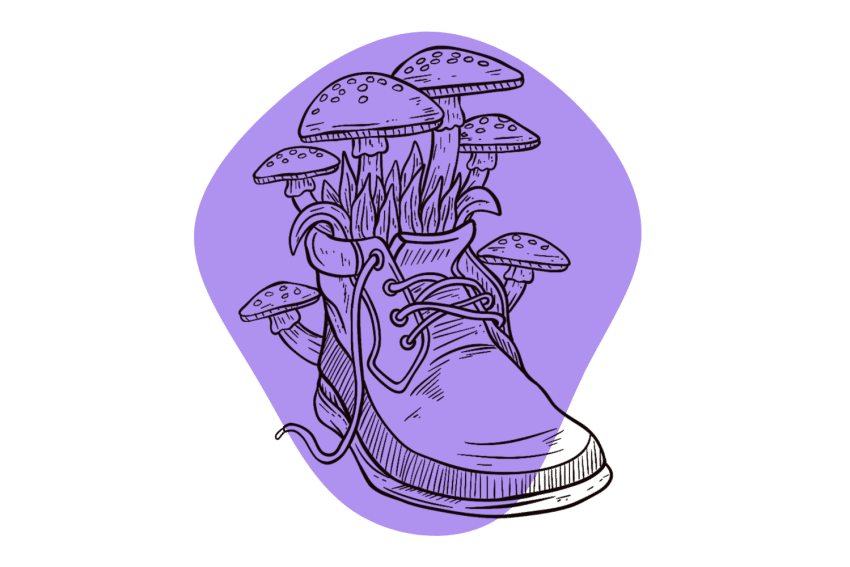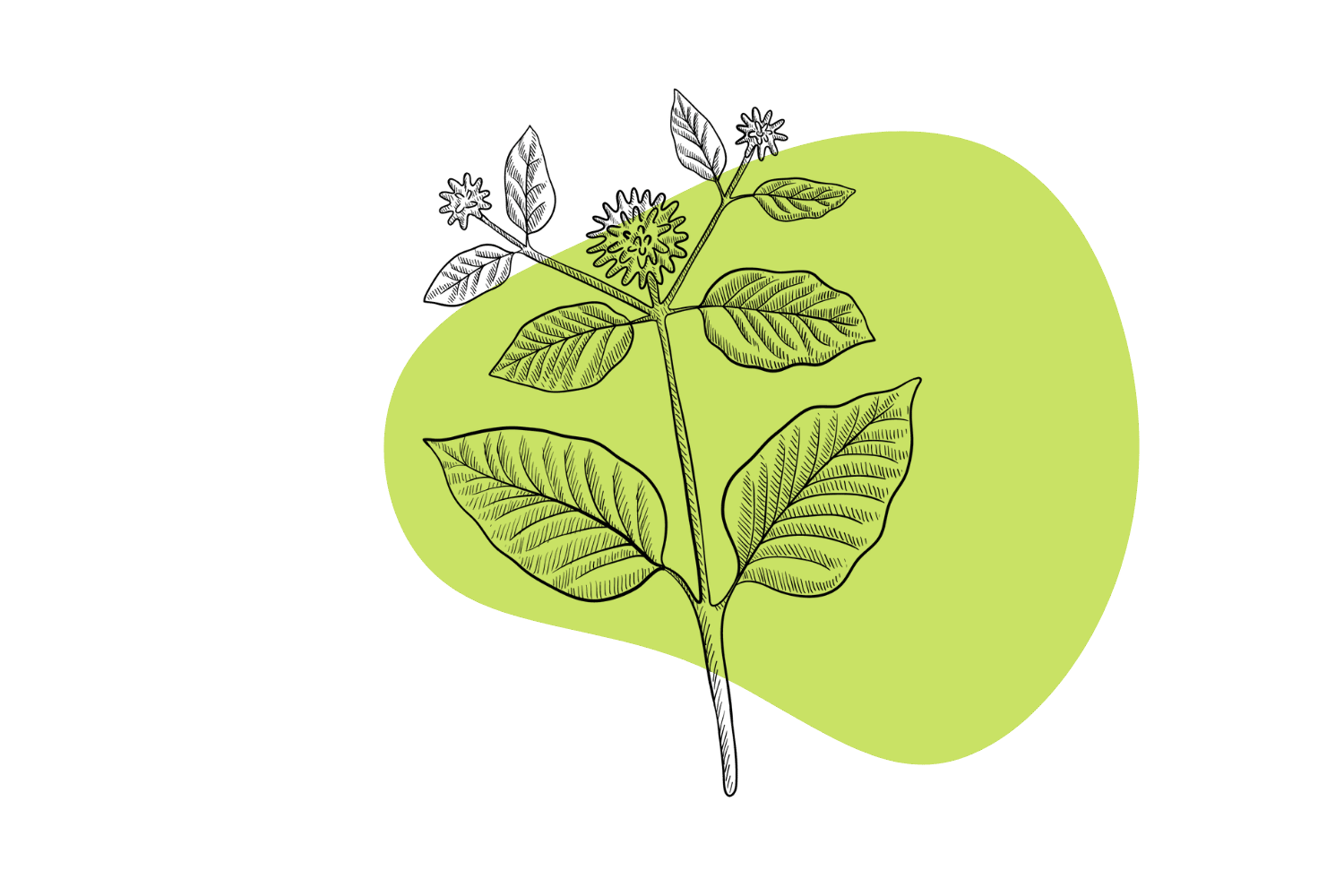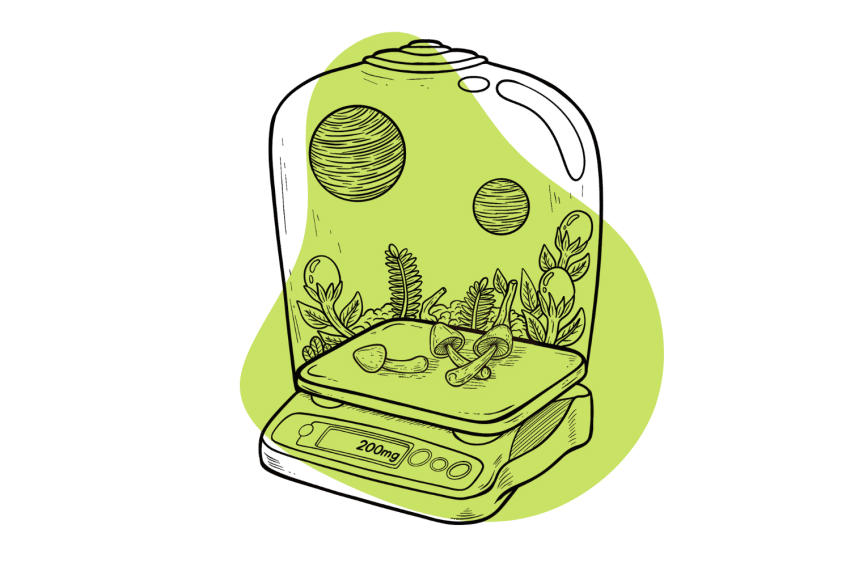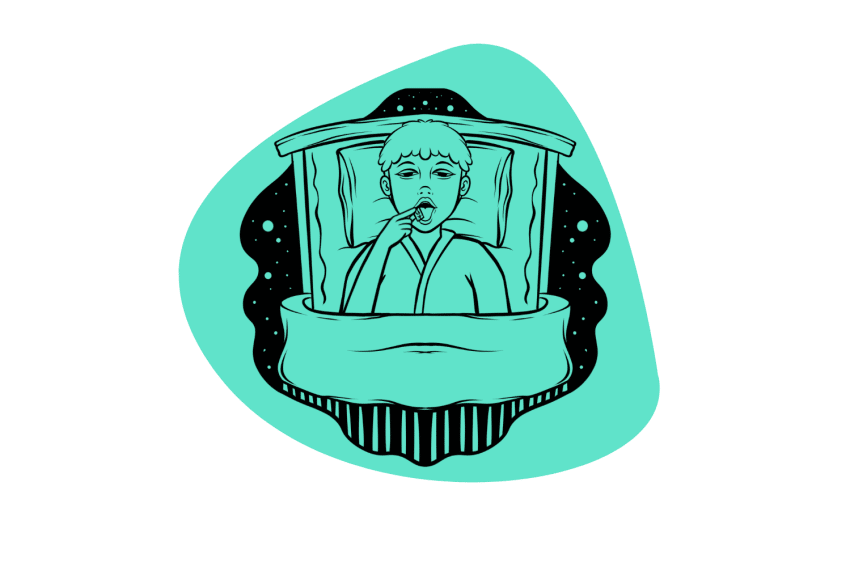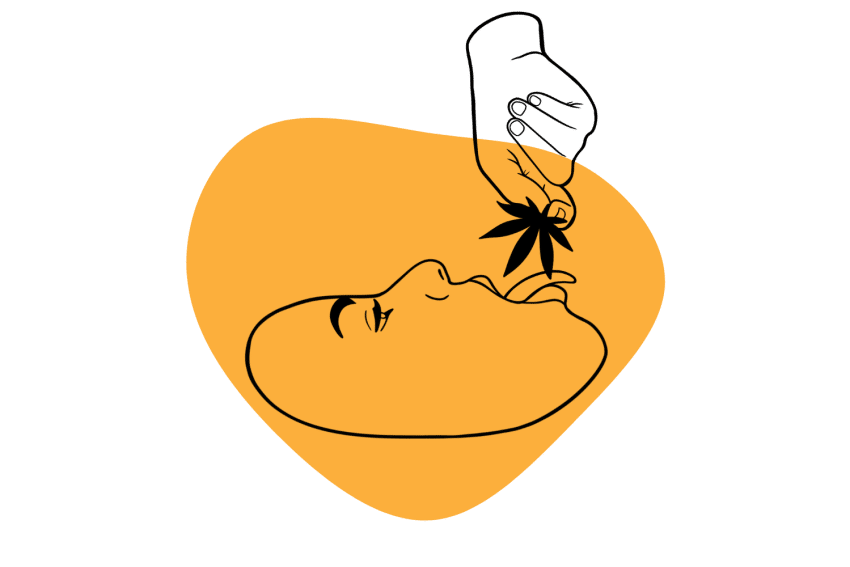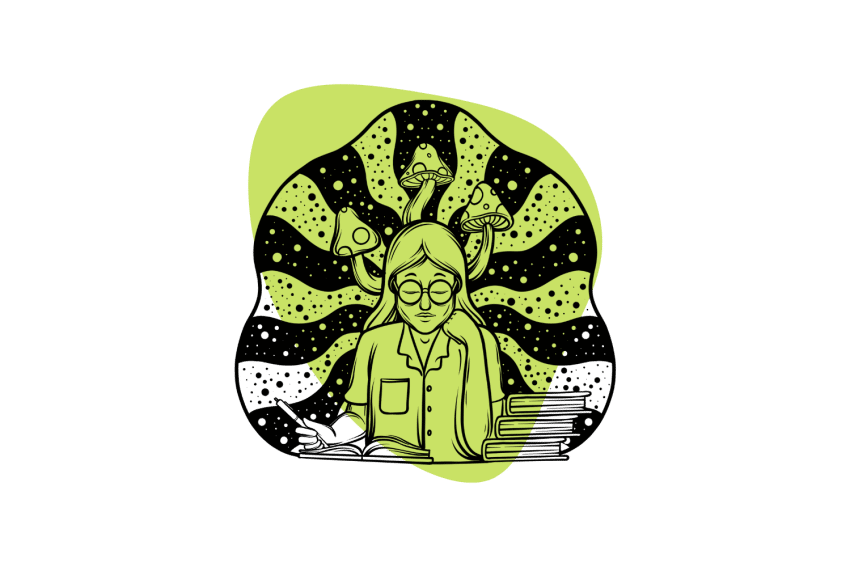Microdosing LSD: A Controversial Practice with Promising Results
LSD is one of the most common substances for people to turn to when looking to microdose, but is it effective? And, if so, what is it good for, and how might it work?
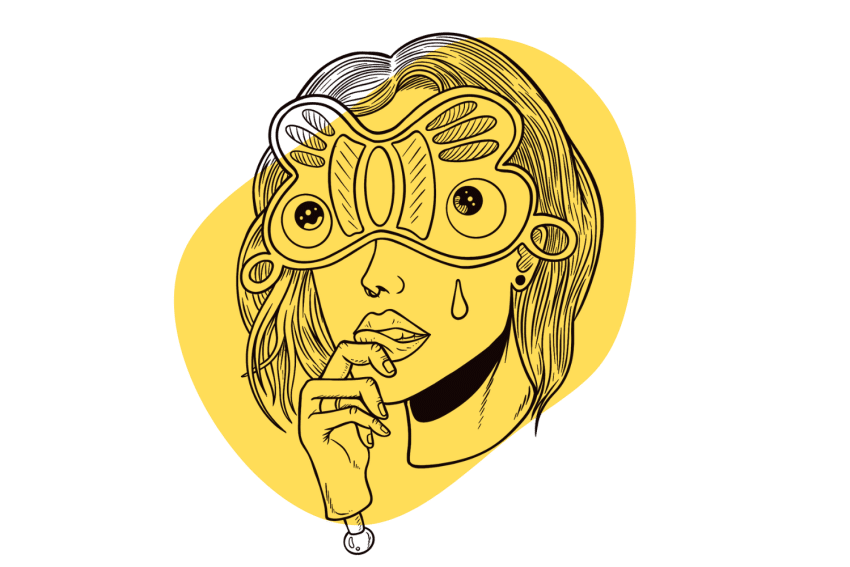
Microdosing has taken the psychedelic world by storm and opened the door for people who would have never considered lysergic acid diethylamide (LSD) in the past.
By definition, a microdose isn’t large enough to produce a perceivable effect — yet people are claiming wide-ranging benefits from the practice.
In this article, we’ll cover everything you need to know about microdosing LSD, including:
- How to Microdose LSD — People usually take 8–20 μg of LSD on alternating schedules. It’s important to set your intentions for the practice, journal about the results, and take periodic (every 1–2 months) breaks.
- Why Do People Microdose LSD — According to one survey of microdosers, the three biggest perceived benefits are (in order) improved mood, focus, and creativity. In total, the survey found more than 10 different reasons why people seek out microdosing.
- Does Microdosing LSD Work? — Research is still lacking on the topic, but there are several potential ways LSD could be beneficial — even if the placebo effect plays a part. Anecdotal evidence is strong, and though some research suggests it’s ineffective, nothing has been able to adequately study the topic or explain the effects microdosers claim.
- Research on Microdosing LSD — Several studies have looked into microdosing LSD for a variety of reasons. Studies into the safety profile of microdosing LSD, its effectiveness, and its effects on the brain paint a hopeful yet skeptical view.
- Microdosing vs. Macrodosing LSD — Do you want something to guide you throughout the day, or is it better to maybe forget what a day even is for a while? Even if you find success in microdosing, it’s likely smart to include a macrodose (or large dose) or two throughout the year as well.
After breaking these down, we’ll go over some frequently asked questions to make sure you’re on the right track.
How to Microdose LSD
Microdosing psychedelics involves taking sub-perceptible amounts of the drug — typically around 1/10th of an active dose. LSD often comes on tabs of blotter paper containing 60–120 μg at a time, and most microdosers will cut them up into 6–10, 8–20 μg pieces.
Since LSD is illegal, attaining a reliable source of LSD may be difficult, so it’s important to test it first. Unfortunately, this won’t tell you how to determine how strong it is, and depending on your source, a single tab could have up to 200 μg in it.
To determine the strength of LSD, it may be best to first take a larger dose to determine the right amount for you to microdose. Start with a half or quarter tab and see how you feel — the threshold dose for LSD is around 50 μg which should cause a light visual effect and minor mood elevation.
From here, you can extrapolate the dosage in a given tab and go from there. Remember, the point of a microdose is to not feel the effects, so bring the amount down if you see patterns start to shift.
Figuring out your dosage is the first step, but you should also determine your schedule, intentions, and when you’ll take your breaks before you begin. Each of these will pay massive dividends in providing a successful microdosing experience.
Different Microdosing Schedules
There are various schools of thought on microdosing schedules, but they all revolve around continuous, repeated use for at least one month. Unlike a macrodose which can hit you all at once and give a loud, clear message, microdosing can take time to start gaining effectiveness.
This time is a large part of what makes studying the practice so difficult — most studies take place over just a few weeks. While continuing the practice reliably is the best way to microdose LSD, it’s also important to take breaks so you can ensure you aren’t building up a tolerance.
The most popular options for microdosing schedules are:
- Dr. Fadiman Standard — This was the first attempt at standardizing the microdose schedule. Dr. Fadiman’s standard is one day on and two days off.
- Three Days On, Two Days Off
- Workdays on, Weekends off
- One week on, one week off
Each person should experiment to find the right option for them, and you may even find something outside of these options that are best for you. Most microdosers report residual effects even on off days, and the rapid tolerance build-up of LSD makes breaks a necessity.
No two people are alike, so feel free to tailor your schedule to your needs.
The Importance of Intention and Healthy Living When Microdosing LSD
Intentionality is often overlooked in microdosing but can create a much more successful experience. Microdosers can maintain this level of mental presence in a few different ways — some examples are to journal, say a mantra, or meditate before taking your morning dose.
Regardless of how you do it, take the extra time to fully address the reason you’re taking the microdose and what you want to accomplish. This should take place before you start a microdosing regime, as well as throughout the experience.
Online forums and subjective reports are slinging a lot of praise around microdosing, but there are no magic pills in life. Even if microdosing LSD is effective, your life and your experience with it will benefit greatly from establishing healthy habits and maintaining your intentions around microdosing.
As you develop your microdosing regime, consider using this time to mark other lifestyle changes and self-care. If you’re willing to take a microdose of psychedelics to increase your feelings of well-being, why wouldn’t you also make an effort to get some daily exercise in to achieve the same effect?
Why You Should Take Periodic Breaks from Microdosing LSD
We know LSD is a safe drug when we take it in even very large doses on occasion, but we don’t know the risks of repeated use of small doses. LSD can elevate heart rate in large doses and may have other physiological effects, which are mostly harmless on their own, but we’re unsure about the effects of recurring use.
Additionally, LSD builds up a rapid tolerance, with one study pointing out that tolerance kicks in within an hour of administration [1]. While this usually involves large, active doses, it’s possible tolerance would build up for microdoses as well.
For these reasons, most microdosers take a break of around 1–2 months every 6–8 weeks. In general, it seems microdosing is likely best after at least two weeks or more, so it’s important to stick with it for a while, but these breaks are crucial as well.
Why Do People Microdose LSD?
There are a few reasons why one may decide to microdose LSD. The most common reason is to boost creativity, help tackle tough problems from a new angle, improve focus and concentration, alleviate cluster headaches or migraines, and even improve sleep.
Often coming on sheets of blotter paper, it’s easy to take a pen knife or other blade and cut these up into small doses.
Magic mushrooms have a strong flavor and aroma, but LSD is flavorless, and you only have to swallow a small piece of flavorless paper.
In a recent survey of 278 people who microdose — 70% of which used LSD — researchers determined the main perceived benefits to be:
- Improved Mood — 26.6% of participants
- Improved Focus — 14.8% of participants
- Creativity — 12.9% of participants
- Self-Efficacy — 11.3% of participants
- Improved Energy — 10.5% of participants
- Social Benefits — 7.6% of participants
- Cognitive Benefits — 5.8% of participants
- Reduced Anxiety — 4.2% of participants
- Psychological Enhancement — 3% of participants
- Reduced Symptoms — 1% of participants
- Other — 2.2% of participants [2]
This wide range of purported effects has led many to treat microdosing as a pharmacological panacea, but research into its effectiveness is still limited. Each of these benefits has a large amount of subjectivity to it — a wide variety of factors can contribute to an improved mood, for example.
Research has demonstrated a large number of people taking a microdose can accurately “break blinding” or guess which group they’re in. This is true even for studies that find it to be comparable to placebo.
What are the Challenges of Microdosing LSD?
There may be a large number of advantages to microdosing, but significant challenges also presented themselves. At 29.5%, the largest of these was by far the illegality of psychedelics and how difficult they are to acquire.
Some of the other difficulties people faced when microdosing included:
- Physiological Discomfort — 18%
- Impaired Focus — 8.8%
- Impaired Energy — 7.2%
- Impaired Mood — 6.9%
- Increased Anxiety — 6.7%
- Increased Symptoms — 6.2%
- Social Interference — 2.6%
- Cognitive Interference — 2.3%
- Self-Interference — 1.2%
- Other — 10.6%
Some of these increased symptoms of anxiety and discomfort could also stem from the prohibition and stigma of psychedelics, but it’s unlikely to account for all of it. While many have found microdosing to be successful, some people find it worsens their symptoms.
As such, microdosing might not be the right tool for everyone and likely doesn’t represent the all-encompassing solution people often paint it out to be.
How Does Microdosing LSD Work?
There are a few different theories on how — and if — microdosing LSD works. Understanding the reason for the varying effectiveness of microdosing is likely the key to understanding how microsdosing works.
These differences can point toward the mechanism of action and shine a light on what’s really going on.
The three main explanations for this are:
- Pharmacological — Asserting LSD’s similarities to serotonin enables it to aid with mood and mental health conditions, even in small quantities. Differing physiological, metabolic, and neurological makeup could be responsible for the alterations in effects.
- Placebo Effect — Our body’s ability to produce the chemicals necessary to meet the expectations we are setting for it. Different expectations could lead to different outcomes if this were the only culprit.
- Boosted Placebo Effect — This explanation is a combination of the two and suggests our expectations, in combination with small doses of serotonergic substances, could strengthen each other. Serotonin plays a big role in the placebo effect, so small doses could assist with this.
If, for example, the physiological differences between users are to blame, this could only be because of an actual pharmacological effect. While the other two solutions point to either a weak effect tied together with our anticipation or a placebo effect altogether.
We are far from conclusive evidence, but these represent potential mechanisms of action for the purported effects of microdosing LSD. Let’s break each down further and discuss how they might work.
Potential Pharmacological Effect of Microdosing LSD
Possible variations in the HTR2A gene responsible for encoding the serotonin 5HT-2A receptor, which plays a crucial role in the effect of LSD, could cause variations in microdosing effectiveness. If this is the case, it would mean LSD affects the 5HT-2A receptor even in indiscernible quantities.
The 5-HT2A receptor is a serotonin receptor, but LSD also interacts with the dopamine receptor 5-HT1A and may have several other effects [3]. In large doses, LSD may result in many of the effects people turn to microdosing for, including elevating mood along with empathetic feelings, openness, happiness, and more.
One of the biggest markers in this study — oxytocin — does come with a caveat of not increasing without a large dose of 200 μg or more. Oxytocin is a neuropeptide (a chemical released by neurons to communicate and adjust the production of chemicals in the brain) responsible for feelings of empathy.
The reporters of this study note its failure to increase without a large dose of LSD, but the subjective feelings of empathy reported by participants are the same at 100 μg. While their oxytocin levels remain stagnant, participants in the study noted they felt the emotion at similar levels.
As such, LSD may evoke empathy and feelings of openness through mechanisms other than the release of this chemical. Whether it works at a microdose is yet unknown, but this doesn’t exclude the possibility.
Does Microdosing LSD Outperform a Placebo?
The placebo effect refers to our body’s ability to rapidly create hormones and boost neurotransmitters to meet our expected effects of a substance. A placebo effect doesn’t mean nothing happens; rather, it refers to when something happens even though it shouldn’t.
Endogenous cannabinoids, opiates, and hormones rise to meet the anticipation we set for them. Placebo-controlled studies are, therefore, more accurate than a study where someone takes a drug and someone else knowingly does not, as it accounts for the body’s ability to treat itself.
While large doses of psychedelics are notoriously hard to control with a placebo since they become obvious rather quickly, microdoses are a different story. By definition, a microdose doesn’t produce a noticeable effect, so it should be easy to measure.
Differing opinions and expectations of a study could also explain the variations in outcome. If you’re expecting something will make you more creative, it’s more likely to do so.
One placebo-controlled study on the effects of microdosing found it to not exceed this effect [4]. The sample size in this study was relatively large — 240 total participants, by far the largest of its type, finished the experiment — making the findings seem pretty definitive.
It’s worth noting. However, 72% of participants accurately guessed when they were on a microdose. The threshold for participants correctly breaking their blinding began at around 13 μg of LSD, so this may be a good marker for future studies and microdosing routines.
Other major limitations of this study, as the authors themself note, include:
- Self-Blinding — Requiring participants to source and prepare their own microdose and placebo increases the risk of them knowing which is which.
- Purity — Self-sourcing means researchers can’t verify the dose or purity of any of the substances.
- Natural Setting — Absent a clinical setting and guidelines, it’s hard to get consistent experiences.
While the report heavily suggests the placebo effect as being the only cause of microdosing’s perceived effects, it’s far from conclusive.
Could Microdosing LSD Bolster the Placebo Effect?
With some evidence on both sides of the discussion, a placebo effect along with the pharmacological effects of LSD may work together. While microdoses of LSD aren’t enough to produce a subjective response, they may assist by stimulating the system and bolstering the placebo effect.
Serotonin and dopamine receptors both play a crucial role in this effect, so smaller doses could assist. The result would be a “Placebo +” effect that bolsters our expectations and anticipation.
Whether this is the case or not will require far more research but the bias of a placebo effect is something any medicine may benefit from. One study in 2014 found a placebo labeled as Maxalt — a migraine medication — was as effective as taking Maxalt with a placebo label [5].
Though the medication makes a difference, the expectations of the subject taking them may determine much of the effectiveness.
Research on Microdosing LSD
We’re a long way from a definitive answer on the efficacy of microdosing LSD, but several preliminary studies have looked into the matter. Criminalization of LSD and the long-term nature of microdosing present massive challenges to researchers.
As such, none of the below findings should form a conclusive answer to what it’s looking into. Here are the insights we’ve found so far:
1. Self-blinding citizen science to explore psychedelic microdosing (2021)
Participants: 240
Design: Participants prepare their own active and placebo doses. They then self-randomize them and scan a QR code to record which one they took [4].
Discovery: “When looking at the between-group comparisons of the same outcomes, no significant differences were found between the placebo and microdose groups.”
2. The effects of microdose LSD on time perception: a randomized, double-blind, placebo-controlled trial (2019)
Participants: 48
Design: Participants took either a microdose or placebo and then performed a series of cognitive surveys throughout the day in a clinical setting [6].
Discovery: “Microdose LSD produces a tendency to over-reproduce suprasecond intervals (or estimate time as longer than it is) on a temporal reproduction task … [and is] most pronounced with a 10 μg dose.” (italics mine)
3. Safety, tolerability, pharmacokinetics, and pharmacodynamics of low-dose lysergic acid diethylamide (LSD) in healthy older volunteers (2020)
Participants: 48 volunteers with a mean age of 69.2 years old.
Design: Participants received repeated doses of 5, 10, and 20 μg of LSD. During dosing, researchers tested their blood plasma levels and performed cognitive testing [7].
Discovery: “Results yielded reassuring data regarding the safety of low dose LSD in an older healthy population … no impairment of cognitive function was observed.”
4. Mood and cognition after administration of low LSD doses in healthy volunteers: A placebo-controlled dose-effect finding study (2020)
Participants: 24
Design: Double-blind, placebo-controlled study with 5, 10, and 20 μg doses. “Thirty minutes to 6 h post-administration, a test battery consisting of questionnaires and computer tasks was conducted, and blood samples were taken” [8].
Discovery: “The majority of observations showed enhanced attention (5, 20 mcg), positive mood (20 mcg), friendliness (5, 20 mcg), arousal (5 mcg), happiness (20 mcg), and a decrease in depression (20 mcg) and anger (10 mcg). Of note, this positive effect on the depression (20 mcg) and anger (10 mcg) is based on half of the total observations, as only 48% of the observations showed a change from placebo after LSD administration.” (emphasis mine)
5. Acute subjective and behavioral effects of microdoses of LSD in healthy human volunteers (2020)
Participants: 20
Design: Participants “attended four laboratory sessions during which they received placebo, 6.5 μg, 13μg, or 26μg LSD in randomized order at one-week intervals. During expected peak drug effect, they completed mood questionnaires and behavioral tasks assessing emotion processing and cognition. Cardiovascular measures and body temperature were also assessed” [9].
Discovery: “These findings indicate that a threshold dose of 13 μg of LSD might be used safely in an investigation of repeated administrations. It remains to be determined whether the drug improves mood or cognition in individuals with symptoms of depression.”
6. Preliminary report on the effects of a low dose of LSD on resting state amygdalar functional connectivity (2019)
Participants: 20
Design: Participants received a microdose or placebo and then underwent functional magnetic resonance imaging (fMRI) scans and filled out questionnaires [10].
Discovery: “These preliminary findings show that a very low dose of LSD, which produces negligible subjective changes, alters brain connectivity in limbic circuits.”
Microdosing vs. Macrodosing LSD: Which is Right For Me?
For most people, a combination of the two is better than choosing one or the other. Microdosing can help get through the day-to-day, but macrodosing enables LSD to make its message far more clear.
The vast majority of LSD research involves macrodoses, bringing on the subjective effects of the drug along with whatever pharmacological effect it may have. These psychedelic — or “mystical” — experiences may be a big part of what makes LSD potentially effective for treatment.
One review of psychedelic studies concluded participants who had such an experience were “a significant predictor of improved outcome in several studies” [11]. This doesn’t mean microdosing couldn’t work as well but, rather, points to the importance of the mystical, psychedelic experience.
Microdosing might be a great practice, and research may vindicate the subjective reports of users from around the world. Even if this were the case, it’s likely still a smart idea to plan a few macrodoses throughout the year or so to see if there’s a bigger message LSD would like to impart.
Microdosing LSD Frequently Asked Questions
Here are some of the frequently asked questions people have about microdosing LSD.
1. Is Microdosing 1P-LSD the Same as LSD?
1-propionyl-lysergic acid diethylamide (1P-LSD) is a research chemical many theorize to be a pro-drug to LSD. After consumption, your enzymes get to work and metabolize off the polycyclic group at the front of the molecule, leaving LSD behind.
For the most part, it’s likely the two drugs act very similarly, aside from 1P-LSD having a slightly lower potency. Additionally, unlike LSD, users should swallow their microdose without placing it on their tongue first since the metabolism has to get to it first.
2. Can You Microdose Liquid LSD?
Yes, microdosing liquid LSD simply involves diluting the liquid to sub-perceptual doses. In order to accurately measure the dose, a strong knowledge of titration and the starting potency of the dissolved LSD is essential.
You can dilute liquid LSD into some water, juice, or other beverage — but make sure it’s room temperature or cooler. High temperatures will destroy the lysergic acid diethylamide.
3. Can You Microdose LSD Gel Tabs?
Yes. LSD gel tabs are a newer form of LSD that are like a blend between a gummy and a conventional LSD blotter square.
Gel tabs contain anywhere from 2 to 3 times the normal dose of LSD, so it’s important to be aware of the specific potency of the gel tabs you’re working with before you start.
Normally, with LSD blotters, we would cut the squares into 9 pieces (roughly 10% of a standard dose). With gel tabs, you may need to go smaller than this or accept a higher dose (around 15–20% of a standard dose).
4. Can You Microdose Other Lysergamides?
LSD is just one of many related substances under the lysergamide family of psychedelics.
Most of these compounds offer similar potency and effects, but when it comes to microdosing, the process is virtually identical.
Some of the more popular lysergamide alternatives include ETH-LAD, PRO-LAD, LSZ, ALD-52, 1P-LSD, and PARGY-LAD.
5. Is Microdosing LSD Safe?
It’s unlikely LSD is any more dangerous in small, repeated quantities than it is in large ones. It’s important to note the physiological effects of LSD — like elevated heart rate — and consider the implications of repeated dosing, however.
One study found it to be a safe practice in older volunteers without a medical condition [7], but this finding is only preliminary. Additionally, users should not turn to psychedelics if they are on certain medications, including cardio, neurological, and hormonal medications.
6. How Might Microdosing LSD Be Effective?
Microdosing LSD may be effective as a pharmacological drug affecting the brain and body, a placebo, or a mixture of the two. To date, research has yet to confirm or deny the effects of microdosing though one has shown it to be comparable to placebo in limited settings [2].
These limitations prevent the research from being conclusive and keep the question very much still alive. While some reports show a physiological or neurological potential effect from LSD, research is still working to confirm or deny the potential.
Ultimately, if microdosing works for you, the research should be secondary as it is likely to take a long time to finalize, and there’s little chance of harm.
7. What’s a Standard Microdose of LSD?
Each person is different, but 8–20μg is a typical microdose of LSD. Especially at the high end, it’s still possible to feel a slight drug effect, so dose carefully and start low, slowly building up over time.
Most say slowly increase until you feel an effect and lower the dose slightly from there. Make sure you figure out your dosage at home and steer clear of driving and operating heavy machinery on microdose days.
8. Is Microdosing LSD Legal?
No. LSD in all forms is currently illegal virtually everywhere.
9. Is Microdosing LSD Different from Other Psychedelics?
Some people claim to get a different effect from microdosing different psychedelics, but this is yet unproven. In large doses, psychedelics seem to contain their own list of effects
This may translate to small amounts, or it might come down to individual expectations. Truthfully, even in large doses, much of these differences may come down to our anticipation of what will happen when we go into the experience.
If you have access to multiple options, try a few out and see which is best for you — or if there’s a difference at all.
References
- Trulson, M. E., & Crisp, T. (1983). Tolerance develops to LSD while the drug is exerting its maximal behavioral effects: Implications for the neural bases of tolerance. European Journal of Pharmacology, 96(3–4), 317–320. https://doi.org/10.1016/0014-2999(83)90323-0
- Anderson, T., Petranker, R., Christopher, A., Rosenbaum, D., Weissman, C., Dinh-Williams, L.-A., Hui, K., & Hapke, E. (2019). Psychedelic microdosing benefits and challenges: An empirical codebook. Harm Reduction Journal, 16(1), 43. https://doi.org/10.1186/s12954-019-0308-4
- Holze, F., Avedisian, I., Varghese, N., Eckert, A., & Liechti, M. E. (2021). Role of the 5-HT2A Receptor in Acute Effects of LSD on Empathy and Circulating Oxytocin. Frontiers in Pharmacology, 12, 711255. https://doi.org/10.3389/fphar.2021.711255
- Szigeti, B., Kartner, L., Blemings, A., Rosas, F., Feilding, A., Nutt, D. J., Carhart-Harris, R. L., & Erritzoe, D. (2021). Self-blinding citizen science to explore psychedelic microdosing. ELife, 10, e62878. https://doi.org/10.7554/eLife.62878
- Kam-Hansen, S., Jakubowski, M., Kelley, J. M., Kirsch, I., Hoaglin, D. C., Kaptchuk, T. J., & Burstein, R. (2014). Altered Placebo and Drug Labeling Changes the Outcome of Episodic Migraine Attacks. Science Translational Medicine, 6(218). https://doi.org/10.1126/scitranslmed.3006175
- Yanakieva, S., Polychroni, N., Family, N., Williams, L. T. J., Luke, D. P., & Terhune, D. B. (2019). The effects of microdose LSD on time perception: A randomised, double-blind, placebo-controlled trial. Psychopharmacology, 236(4), 1159–1170. https://doi.org/10.1007/s00213-018-5119-x
- Family, N., Maillet, E. L., Williams, L. T. J., Krediet, E., Carhart-Harris, R. L., Williams, T. M., Nichols, C. D., Goble, D. J., & Raz, S. (2020). Safety, tolerability, pharmacokinetics, and pharmacodynamics of low dose lysergic acid diethylamide (LSD) in healthy older volunteers. Psychopharmacology, 237(3), 841–853. https://doi.org/10.1007/s00213-019-05417-7
- Hutten, N. R. P. W., Mason, N. L., Dolder, P. C., Theunissen, E. L., Holze, F., Liechti, M. E., Feilding, A., Ramaekers, J. G., & Kuypers, K. P. C. (2020). Mood and cognition after administration of low LSD doses in healthy volunteers: A placebo controlled dose-effect finding study. European Neuropsychopharmacology, 41, 81–91. https://doi.org/10.1016/j.euroneuro.2020.10.002
- Bershad, A. K., Schepers, S. T., Bremmer, M. P., Lee, R., & De Wit, H. (2019). Acute Subjective and Behavioral Effects of Microdoses of Lysergic Acid Diethylamide in Healthy Human Volunteers. Biological Psychiatry, 86(10), 792–800. https://doi.org/10.1016/j.biopsych.2019.05.019
- Bershad, A. K., Preller, K. H., Lee, R., Keedy, S., Wren-Jarvis, J., Bremmer, M. P., & De Wit, H. (2020). Preliminary Report on the Effects of a Low Dose of LSD on Resting-State Amygdala Functional Connectivity. Biological Psychiatry: Cognitive Neuroscience and Neuroimaging, 5(4), 461–467. https://doi.org/10.1016/j.bpsc.2019.12.007
- Ko, K., Knight, G., Rucker, J. J., & Cleare, A. J. (2022). Psychedelics, Mystical Experience, and Therapeutic Efficacy: A Systematic Review. Frontiers in Psychiatry, 13, 917199. https://doi.org/10.3389/fpsyt.2022.917199

